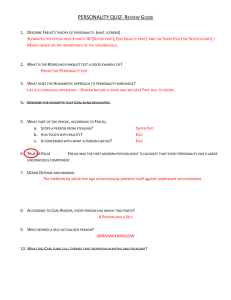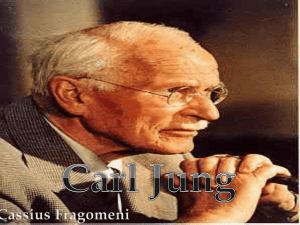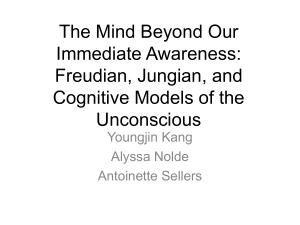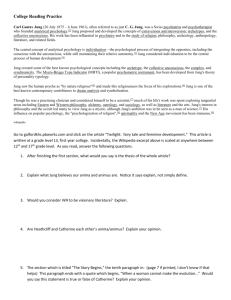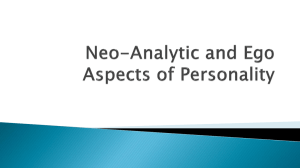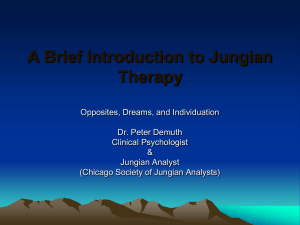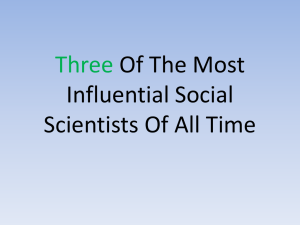Jungian Counseling
advertisement
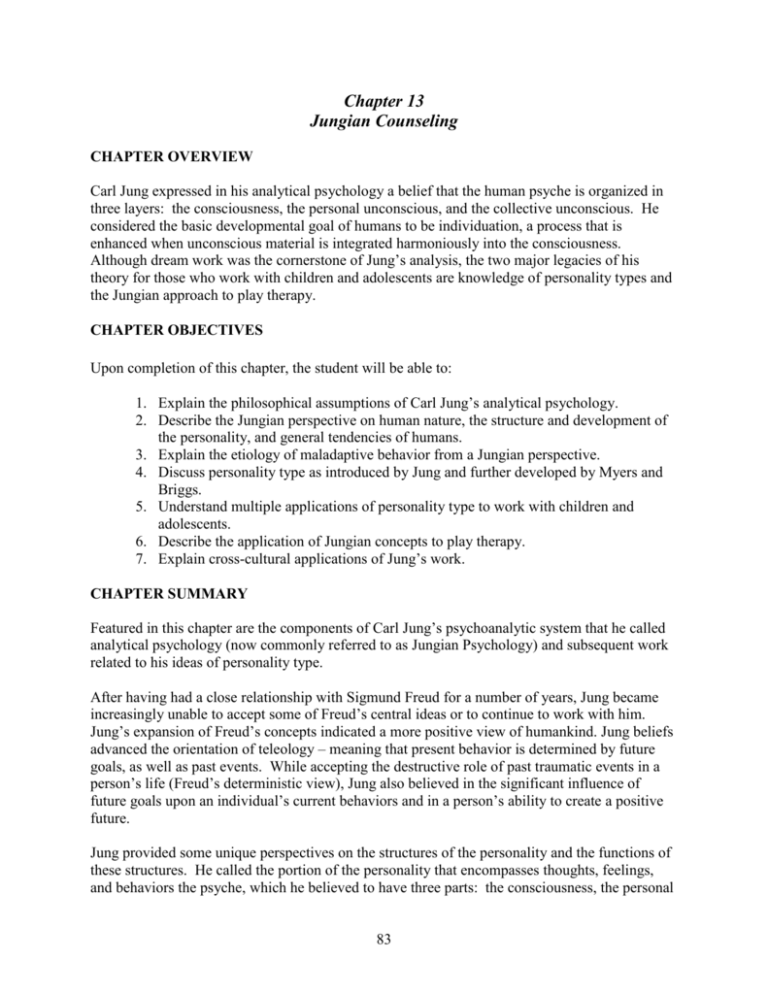
Chapter 13 Jungian Counseling CHAPTER OVERVIEW Carl Jung expressed in his analytical psychology a belief that the human psyche is organized in three layers: the consciousness, the personal unconscious, and the collective unconscious. He considered the basic developmental goal of humans to be individuation, a process that is enhanced when unconscious material is integrated harmoniously into the consciousness. Although dream work was the cornerstone of Jung’s analysis, the two major legacies of his theory for those who work with children and adolescents are knowledge of personality types and the Jungian approach to play therapy. CHAPTER OBJECTIVES Upon completion of this chapter, the student will be able to: 1. Explain the philosophical assumptions of Carl Jung’s analytical psychology. 2. Describe the Jungian perspective on human nature, the structure and development of the personality, and general tendencies of humans. 3. Explain the etiology of maladaptive behavior from a Jungian perspective. 4. Discuss personality type as introduced by Jung and further developed by Myers and Briggs. 5. Understand multiple applications of personality type to work with children and adolescents. 6. Describe the application of Jungian concepts to play therapy. 7. Explain cross-cultural applications of Jung’s work. CHAPTER SUMMARY Featured in this chapter are the components of Carl Jung’s psychoanalytic system that he called analytical psychology (now commonly referred to as Jungian Psychology) and subsequent work related to his ideas of personality type. After having had a close relationship with Sigmund Freud for a number of years, Jung became increasingly unable to accept some of Freud’s central ideas or to continue to work with him. Jung’s expansion of Freud’s concepts indicated a more positive view of humankind. Jung beliefs advanced the orientation of teleology – meaning that present behavior is determined by future goals, as well as past events. While accepting the destructive role of past traumatic events in a person’s life (Freud’s deterministic view), Jung also believed in the significant influence of future goals upon an individual’s current behaviors and in a person’s ability to create a positive future. Jung provided some unique perspectives on the structures of the personality and the functions of these structures. He called the portion of the personality that encompasses thoughts, feelings, and behaviors the psyche, which he believed to have three parts: the consciousness, the personal 83 unconscious, and the collective unconscious. He expanded Freud’s belief regarding the libido to include the idea of energy through which the work of the personality is performed. He described the first part of the psyche, the consciousness, as the portion that is known to the person. He wrote that within the consciousness are the four mental functions of thinking, feeling, sensing, and intuiting; and the two attitudes of introversion and extraversion. He considered the second part of the psyche, the personal unconscious, to be the storehouse of experiences (e.g., information, ideas, feelings, memories, perceptions) that are held from a person’s awareness by the ego. He believed that the ego provides an identity to the personality by serving as a gatekeeper of what may enter from the personal unconscious into consciousness. In simplest terms, Jung indicated that the ego prevents material that is inconsistent with or threatening to the personality from entering consciousness. He wrote of the ways that the gate keeping tasks of the ego are significantly influenced by the individual’s dominant mental function (thinking, feeling, sensing, or intuiting) and by anxiety. Jung believed that within the personal unconscious there are clusters of ideas or common experiences that he referred to as complexes. He indicated that a complex (for example, an inferiority complex) has the power to impact behavior negatively when kept from conscious awareness, but can be dissolved through introduction to consciousness in analysis. Jung espoused the concept of individuation, the process of becoming a psychological individual. According to this theory, humans are born whole, with an innate capacity to grow toward a unique potential. Individuation equates to extensive self-knowledge and involves the development of highly specialized functions within a balanced whole. He believed the purpose of psychotherapy was to help a person find balance and restore wholeness through increased selfknowledge. Jung uniquely described a bottom layer of the psyche as the collective unconscious, the contents of which he called archetypes. These are non-visual images shared by all human beings as a result of evolution and genetic inheritance. Fueled by his interest in dream content and by his first-hand studies of Native American and African tribal stories and myths, Jung wrote extensively of these universal thought forms. Jung felt that the archetypes of the self, the anima and animus, the shadow, and the persona are of particular importance in the human psyche. The considerable influence of Jung’s ideas about psychological type has been due in large part to the work of a mother-daughter team who developed an inventory, the Myers-Briggs Type Indicator (MBTI). Intended as a tool for self-understanding and decision-making, the instrument measures preferences in four categories: (1) energizing, the attitude that determines a person’s style for renewal of psychic energy, either extrovert or introvert; (2) attending, the function of finding-out, gathering, and taking-in information, either sensing or intuition; (3) deciding, the function of preference for decision-making, either thinking or feeling; and (4) living (a category developed for the inventory that was less explicit in Jung’s writings), a preference for orientation to the outer world, either judging or perceiving. Individual preferences on these four categories combine to form one of 16 types. Jung believed that a person’s preferences have a ranking from most to least dominant, and that the less dominant functions can be the focus of growth as one 84 moves through the individuation process. The Murphy-Meisgeier Type Indicator for Children (MMTIC) has been developed for identifying type in children in approximately second through eighth grades. An understanding of preferred personality type can have numerous positive implications for work with children and adolescents. Because there is no right or wrong preference or type, the focus is on strengths of an individual. This knowledge can be a tool for providing considerable encouragement to a child, especially when he or she may feel “one down” in comparison to significant others who have different preferences. Counselors, teachers, and parents may be most effective when they also understand their preferred type. The knowledge of type can help adults recognize and appreciate differences among children, including behavioral differences, and differences of individual children from themselves. It can help them provide diverse learning opportunities for divergent learning styles. A discussion of the preferences includes some of the typical activities that reflect those styles as well as preferences in learning. Jungian followers believe that accommodation for a child’s type can provide psychological safety and a greater degree of immediate and long-term success for the child. When applying Jungian type to the counseling process, the following steps are suggested: (1) establish a relationship; (2) analyze the present situation; (3) increase the client’s awareness of the present situation; and (4) help the client gain awareness of him or herself that will enable her to effectively manage future situations. KEY CONCEPTS 1. 2. 3. 4. 5. 6. 7. Human behavior is influenced by past events and by future goals. Personality or psyche is composed of the consciousness, the personal unconscious, and the collective unconscious, as well as the contents of each of these structures. Maturation is defined in terms of individuation, or the process of becoming increasing aware of self and of one’s individuality. Humans are born whole, but circumstances can cause an erosion of that wholeness. The goals of Jungian analysis are to help patients recover their wholeness and to strengthen their psyche through a process of integrating unconscious material into consciousness. Individuals have different pathways to development due to their personality type, which is the combination of their inborn preferences. When working with children, one can use knowledge of personality type in efforts to accommodate different learning styles, to provide psychological safety for children, and to help them better understand and accept themselves. KEY TERMS, CONCEPTS, and PERSONALITIES Anima – The archetype that is the feminine side of the male psyche. Animus – The archetype that is the masculine side of the female psyche. 85 Archetypes – Unconscious, universal prototypes or non-visual images representing instinctual behaviors (ex., the hero, the earth mother, the wise old man, etc.). Carl Jung – The founder of Analytical Psychology. Collective Unconscious – The portion of the psyche that houses material that has been inherited genetically from ancestors. Complex – A cluster of common ideas or experiences stored within the unconscious. Consciousness – The part of the psyche that is known to the person, incorporating the four mental functions of thinking, feeling, sensing, and intuiting and the two attitudes of extraversion and introversion. Ego – According to Jung’s revision of this Freudian term, the organization of information, feelings, memories, and perceptions; the gatekeeper to the consciousness. Extroversion – An individual preference for the outer world and responses to it. As defined in the MBTIb, an extrovert primarily draws energy from people, the environment, and activities. Feeling – A preference for value-based, person-centered, empathic decisions. Individuation – A process by which the person becomes a psychological individual, involving the expansion of consciousness by knowing and understanding oneself as completely as possible. Introversion – An individual preference for the inner world and the responses and reflections upon that inner world. As defined in the MBTIb, the introvert primarily draws energy from within, from internal concepts and ideas. Intuition – The preference for using the facts to make a bigger picture of what is visible beyond the information from the senses, to see connections and possibilities. Judging –A preference for external order, organization schedules, systems, planning, and closure. MBTIb – Myers-Briggs Type Indicatorb. An assessment instrument designed to help people understand their preferred psychological type. MBTICb – Murphy-Meisgeier Type Indicator for Childrenb. An assessment instrument designed to help children in approximately grades two to eight understand their preferred psychological type. Perceiving – A preference for flexibility, spontaneity, adaptability, and options, with less need for external order. Persona – The archetype that is the display of a public face, façade, or mask for the purpose of gaining acceptance in society. 86 Personality (or Psychological) Type – The combination of personal preferences related to attitudes, mental functions, and orientation to the outer world. Personal Unconscious – The portion of the psyche containing an individual’s experiences, memories and ideas that the ego does not allow into consciousness. Psyche – The part of the personality that embodies thoughts, feelings, and behaviors – both conscious and unconscious. Psychic Energy – The libido or energy through which the work of the personality is performed. Sensing – The preference for taking in information through the senses – sight, touch, hearing leading to a focus on facts, the concrete, and the present. Shadow – The archetype that represents the hidden, repressed, primitive, guilt-laden part of the personality. Thinking – A preference for analytical, logical, objective, “tough-minded” decisions. REVIEW QUESTIONS 1. According to Jung, a person’s current behavior is determined: A. primarily by events that have occurred in the past. B. by a combination of events of the past and goals for the future. C. primarily as a result of need fulfillment and anxiety reduction . D. by resolution of inner conflict. 2. Jung believed which of the following acts as the gatekeeper to the consciousness: A. the collective unconscious B. the id C. the ego D. an archetype 3. Which of the following is NOT true of Jung’s concept of individuation? A. This process takes place primarily while one is dreaming. B. This process represents Jung’s primary theory of human development. C. This process takes place through expanding consciousness. D. This process takes place through knowing and understanding oneself as completely as possible. 87 4. According to Jung, the purpose of psychoanalysis is to help a person: A. resolve intrapsychic conflict by reducing tension between the id and the superego. B. restore balance and “wholeness” through increased self knowledge. C. develop a system of problem-solving that would be useful in most areas of daily living. D. rid themselves of the primitive desires of the collective unconscious that may be disruptive to interpersonal relationships. 5. Jung called the inward feminine side of the male psyche the: A. persona. B. shadow. C. anima. D. animus. 6. Jung used the term ________ to describe an exaggerated sense of self-importance that is not based on a real estimation of one’s abilities. A. inflated ego B. extraordinary complex C. inflated persona D. inferiority complex 7. Which of the following is NOT part of Jung’s description of one’s shadow? A. An archetype B. A person’s basic animal instincts C. Hidden, repressed, guilt-laden aspects of the personality D. A complex 8. Jung believed that dreams: A. can best be interpreted with the aid of a defined set of symbols. B. are not under the influence of consciousness or the will. C. are best analyzed individually rather than in themes or series. D. are almost exclusively the products of archetypes in the collective unconscious. 9. In the space provided, write the contrasting preference of each pair: Introvert - ________________ Sensing - ________________ Thinking - ________________ Judging - ________________ 88 10. According to meanings attached to the term by Jung and Myers/Briggs, if Rachel is an “extrovert” she would: A. become re-energized from the external world and through interactions with people. B. inevitably be very talkative. C. inevitably expend so much energy in active participation with others at a party that she would be “spent” when she returns home. D. find much more pleasure in parties than would an introvert. 11. Francois is an 8-year-old boy who is most frequently analytical, logical, and objective in his decision-making. It is probably that on the MBTICb he would score high on preference for the function of ______________. ESSAY QUESTIONS 1. Discuss specific ways in which it would be advantageous for Sylvia Valdez, the owner of an art gallery, to use both sides of each of the following preferences in her work responsibilities: sensing and intuition; thinking and feeling; and judging and perceiving. 2. Compare and contrast Jung theories of human development and psychoanalysis with Freud’s theories. In your discussion provide a minimum of six similarities and six differences. ACTIVITIES 1. Obtain a copy of the MBTIb and complete this inventory as a way to begin to understand your own personality type. This instrument is frequently available at university counseling centers where appointments can also be made to discuss the results. Better yet, ask a partner or one or more close friends to do the same, compare results, and discuss the different strengths that each of you brings to your various relationships and responsibilities. 2. Imagine that you are an elementary school counselor who has been informed that you will be coordinating the administration of the MMTICb to every child in your school. You become aware that you have a greater level of enthusiasm than some of the classroom teachers. Prepare a detailed outline of your presentation to the faculty that is intended to inform and inspire them to welcome this opportunity 89


